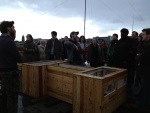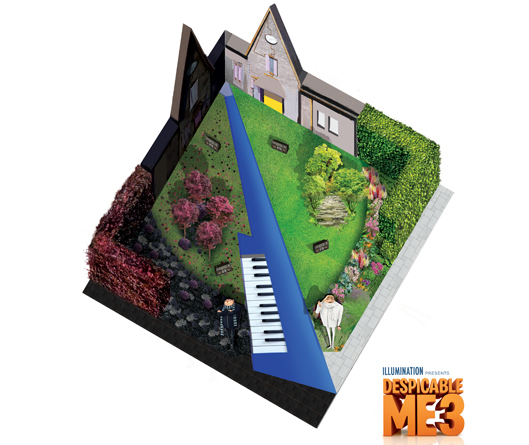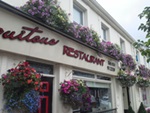
There is always a tendency to consider food growing as something that always has to happen in a field or large garden – GIYing is, unfortunately, often considered the preserve of country people or farmers. In reality, it’s an equally viable hobby in an urban environment. Every vegetable you could possibly want to grow, can be grown just as successfully in a container on an apartment balcony.
In fact, if we are to provide a genuine alternative to the modern food chain, then food growing is something that is going to have to happen in much smaller spaces, and in spaces that people might not always associate with food growing. I visited two projects in Dublin recently that really challenge your assumptions about where food can be produced. The first is Kaethe Burt O’Dea’s blink- and-you-miss-it community garden on Sitric Road in Stoneybatter. The second is what you might call a ‘hyper-urban’ food growing space on the roof of the Chocolate Factory on King Inns Road, a stone’s throw from O’Connell St.
The Sitric Community Garden is literally a street corner, a sliver of green space at the end of a terrace of two-up/two-down houses. In this tiny space, there is a surprising amount of food growing occurring – even a February visit (not the best time of year) revealed an amount of edible greenery, an abundance of herbs and even some fine globe artichokes. The garden has got around the obstacle of a lack of soil, by becoming exceptionally good at producing compost – they take raw materials (kitchen waste and the like) from surrounding houses and using a number of different composting systems (compost bays made with recycled bricks and standard compost bins), create ‘black gold’ in which to grow food.
Many of the houses in the area have no gardens (or small concrete ones), so the community garden is fulfilling a vital ‘greening’ function. But perhaps more importantly it is helping to foster community spirit by bringing people together in the neighborhood who have a common interest. Like most community growing initiatives the people involved get a sense of connectedness but also lots of knowledge. An example of the former are the renowned barbecues and street parties with salads provided from the garden, while an example of the latter is the regular compost ‘bootcamps’ being held in the garden.
A mere 15 minutes walk away, is the astonishing Urban Farm project at the Chocolate Factory, devised by Andrew Douglas. High atop the old Williams & Woods building is a project that will sweep away any assumptions you might have about food and where it should come from. The project aims to create something positive from a negative space by demonstrating and researching intensive growing techniques, while at the same time acting as a space for community groups to meet and get trained in food growing. By cultivating a network of urban farmers, it hopes to catalyse social changes that will improve the livelihood and liveability of our city spaces. An unlikely brood of hens wanders around on the roof, scratching in compost heaps. There are plans for beehives and the plush 4 Seasons hotel in Ballsbridge has already agreed to buy the honey to use in expensive spa treatments. A soon-to-open café on the ground floor will buy salads and more – distance from ‘farm to fork’, well zero miles I guess, but in reality, several flights of stairs.
Everything here is either recycled or up-cycled – old pallets are used to construct planters and compost bays. Diageo have donated huge containers that are used to transport Baileys to capture rain water. Fertilizer drums with Wavin pipes standing in the centre, have been painstakingly re-imagined to act as wormery/planters (strawberry plants and the like can be planted around the sides while the worms provide nutrients from the centre). The day I visited a volunteer was painstakingly creating the planting holes on one such drum.
He proudly pointed to a stack of literally hundreds of blue drums in the corner, that must have taken hundreds of hours to produce. Some old furniture, a fish tank and 2l mineral bottles have been used to create a state-of-the-art aquaponics system – fish swim around in the fish tank beneath a planting system where strawberry plants are grown in the upturned mineral bottles.
The fish create manure, which creates minerals to feed the strawberry plants. The strawberry plants filter the water which is then returned clean to the fish tank. A brilliant, closed loop system, which shows how efficient and productive it is when we work symbiotically with nature to produce food (instead of working against it). In theory, they may even be able to breed trout and perch in these systems that can be sold to the restaurant downstairs. It’s like something you can imagine Willy Wonka inventing, if he were a GIYer.
Andrew and his team have brought a really funky technology edge to proceedings – the aquaponics system is hooked up (in a way I couldn’t really understand) to twitter. The fish somehow tweet when they are hungry and the plants tweet when they are dry. This is a food-growing/fish-breeding system that’s monitored by social media. Technology also came to the rescue when the Urban Farm project needed funding – they managed to raise up to €5,400 on the Fund it website, a great example of the power of crowd funding.
One imagines that the future of the food chain may well look something like the Sitric Community Garden and Urban Farm projects – necessarily small- scale but riotously creative, innovative and resilient. It won’t be about 1000- acre mono-cropping mega farms. It will be about small, interconnected community growing systems, and the whole being greater than the sum of its parts. Let’s hope so.
Source: GIY Ireland – Urban Growing





